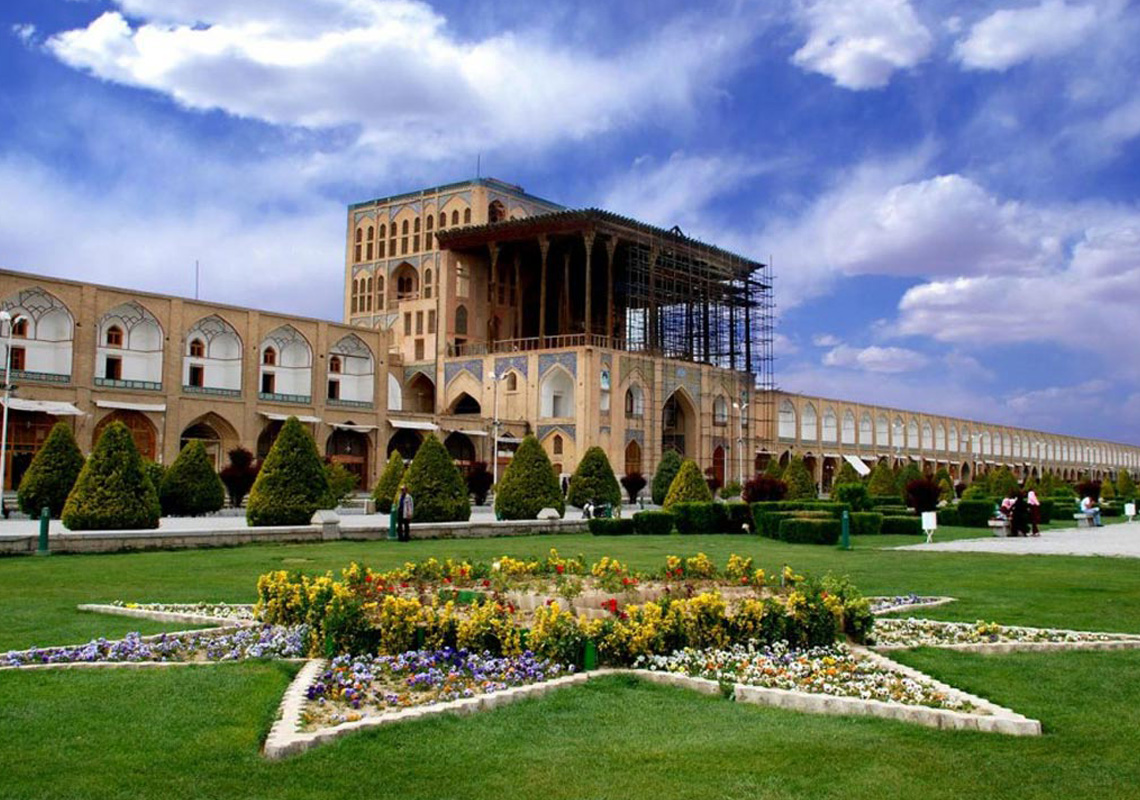Aali Qapu is the largest palace that may existed in a capital city. It was considered one of the best palaces in the world in the Safavi era, with all the benefits of a royal palace. Aali Qapu is a mansion on the west side of Naqshe-jahan Square and in front of the Sheikh Lotfollah Mosque.
This beautiful palace is known as one of the most important architectural masterpieces of the early eleventh century. The date of construction of Qapu's monument goes back to 1054 AH. This palace was founded by King Abbas I.
Aali Qapu was the central gateway to all the palaces which were built during the Safavi era in the Naqshe-jahan Square area.
The Aali Qapu building with 36 meters high from the market floor, has been the tallest multi-stored mansion in Isfahan for decades. Due to architectural additions on each side, this palace has a different look from different point of views. From in front of the square, it has a two-store and from behind it has five store view.
Around Naqshe-jahan Square many house accommodations in Isfahan existed. Nowadays historical residences in Iran host many tourists during a year. In close approximate of Aali Qapu palace we can mention kianpour boutique hotel which is only 2.8 km away from this historical place in Isfahan. The guests of Kianpour boutique hotel in Isfahan can use public transportation such as subway, bus, taxi and so on or take a walk to this destination.
In general, the upper building of Aali Qapu consists of two distinct parts: the front and the entrance to the main building of the palace.
Above the entrance, there is a porch that is open in 3 directions and has a wooden room. In past, when they needed a close porch, the porch was covered with curtains.
The pool with marble edges and fountains in the middle of the porch is made of copper. Tourist writings such as Taronie and Chardin suggest that in the past, the porch's bottom, wall and column surfaces were decorated by mirrors.
So the porch, or in other words, the hall, according to the book of qesas al-khaqani, started to be constructed in 1053.
The entrance leads to an atrium, which is made north-south. Behind this corridor lies the majestic upper mansion of Aali Qapu.
But Aali Qapu building consists of six floors. There are two stone platforms at the entrance to the 6-storey mansion. There is also a staircase above this door, some of which has trimed over time.
The carburetor, which is located at the entrance, has a high roof with the same size of the front entrance. In the same junction, at the entrance of the other main building, there are two platforms on either side connecting to the back yard.
Above this door is a window through which light shines into the canvas. The rooms around this yard were in fact governmental offices.
The two spiral staircases on the first two corners of the first floor were form the communication path.
The first high-rise hall opens to the front porch by a large door. On the walls of this hall there are beautiful and colorful paintings, often from Reza Abbasi's works.
The sixth floor of the Aali Qapu Palace has a large hall that is completely plastered. This hall, also known as the sound chamber. It is built on the physics of sound recognition and reflection in a way that, like a recording studio, eliminates additional sound resonance and delivers sound to all parts of the hall. The walls of the surrounding rooms are also decorated with beautiful paintings.
What makes Aali Qapu great in a number of magnificent and exquisite works, in addition to Reza Abbasi's miniatures, is the floor-to-ceiling design, which is also known as the "Music Room" or "Sound Room".
In this part of the palace, a variety of cups and wallpapers are embedded in the wall that make and address these forms in addition to displaying the beauty, by creativity and ingenuity of the plaster artists, in order to reflect on the musicians, shapes are taken and sounds are heard naturally and without reflection.
In general, the building of Aali Qapu as a beautifully constructed and beautiful ceremonial palace is another achievement of the art of the Safavi era.
Although irreparable damage has been done to the decoration of the building since the Safavi era, it still contains masterpieces of plasterwork and paintings of the Safavi era that are admired by visitors.
Artistic miniatures by Reza Abbasi, the famous painter of the Shah Abbas era, flower and shrub paintings, foliage, bean and poultry shapes, and its beautifully decorated cups and walls are embedded in arches and walls. The king and his guests used to sit at the same mansion watching landscapes of poles, lights, fireworks and field plays.
Aali Qapu is the largest palace that may exist in a capital city. So it can be said that it was considered one of the best palaces in the world in the Safavi era and hence has all the benefits of a royal palace.







